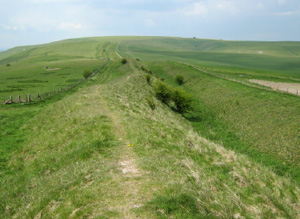This area is the western most extent of the high chalk downlands of Wiltshire and Berkshire.
An archaeologically exceptional landscape relating to the prehistoric period with Neolithic and Early Bronze Age evidence being particular important. Significant areas of open downland survive these are an important historical survival representing a fraction of the former extent of pre 20th century open grazed chalk downland. The area is partly within the landscape of the Avebury World Heritage Site.
North Wessex Downs AONB HLCA Extract 1
Present Day Historic Landscape Character

The present day historic landscape character is dominated by 20th century enclosure. This is divided roughly into two types. In the east new fields were created by ploughing up of open chalk downland. These fields are usually regular in shape and have straight boundaries. In the west fields were created in the 20th century by modifying earlier 17th to 19th century enclosure.
New Woodland creation occurred in the form of the development of secondary deciduous woodlands dating from 1600 to 1800 on Kings Play Hill and post 1800 regular plantations of woodland.
Layers in the Landscape

The archaeological record is dominated by prehistoric archaeology. This includes evidence for intense Mesolithic exploitation of the area recorded as flint scatters including the large scatter excavated at Golden Ball Hill. The Neolithic evidence is particular rich this includes sites within the boundary of the Avebury World Heritage Site. However nationally important Neolithic and early Bronze Age monuments also extend across the rest of the area and in some instances are in as good a state of preservation. There is significant cropmark evidence of later prehistoric field systems (later Bronze Age and Iron Age) and farming across the areas.
Early Medieval archaeology is dominated by the Wansdyke which runs along the southern escarpment marking the southern boundary of the area. Archaeological potential is extremely high across this area.
Open areas of close-cropped chalk grassland formerly dominated this area. This was used as grazing for animals. The land was also associated with small patches of scrub and gorse, which were used as fuel, and meandering open chalk trackways, used to cross this area. These open areas used as part of the common grazing regime that operated in many Downland parishes in the Medieval period.

Historic Settlement Character
Historically the area was devoid of settlement in the Medieval and Post Medieval period. Isolated agricultural cottages were created as arable farming spread into the area.
Historic Farmstead Character
Post 1800 isolated field barns were created as arable farming spread into the area but compared to other areas the historic farmstead legacy is less significant.



